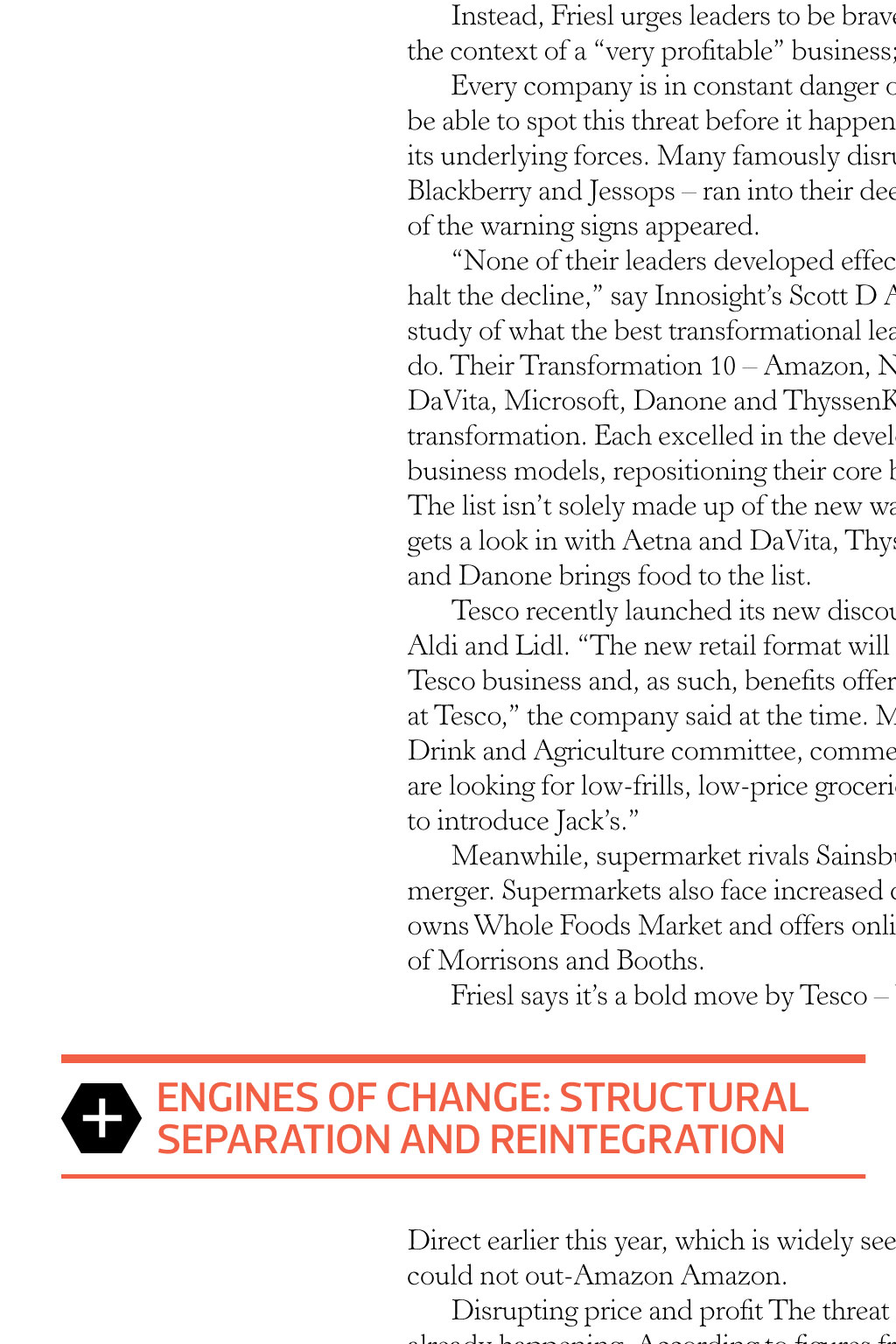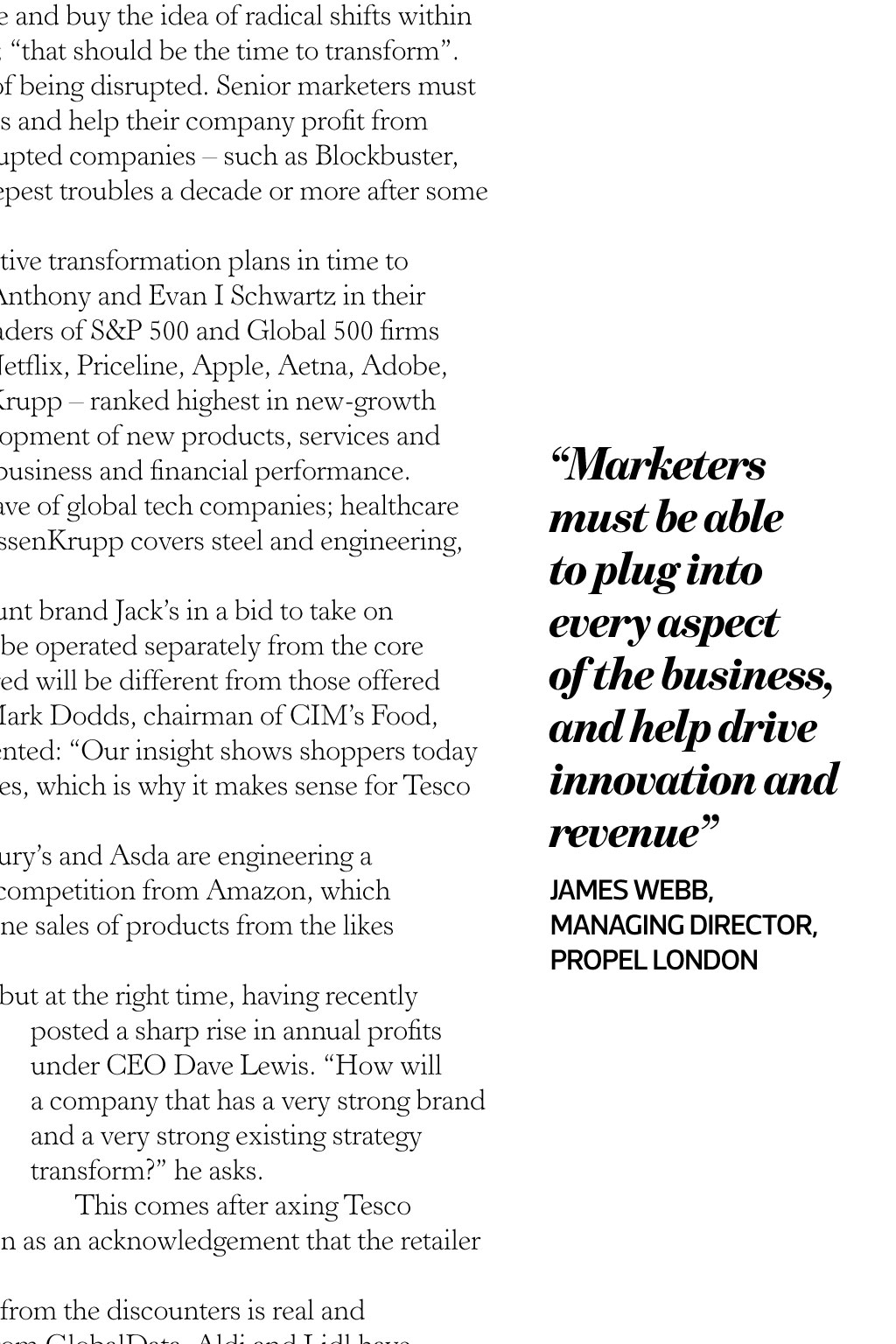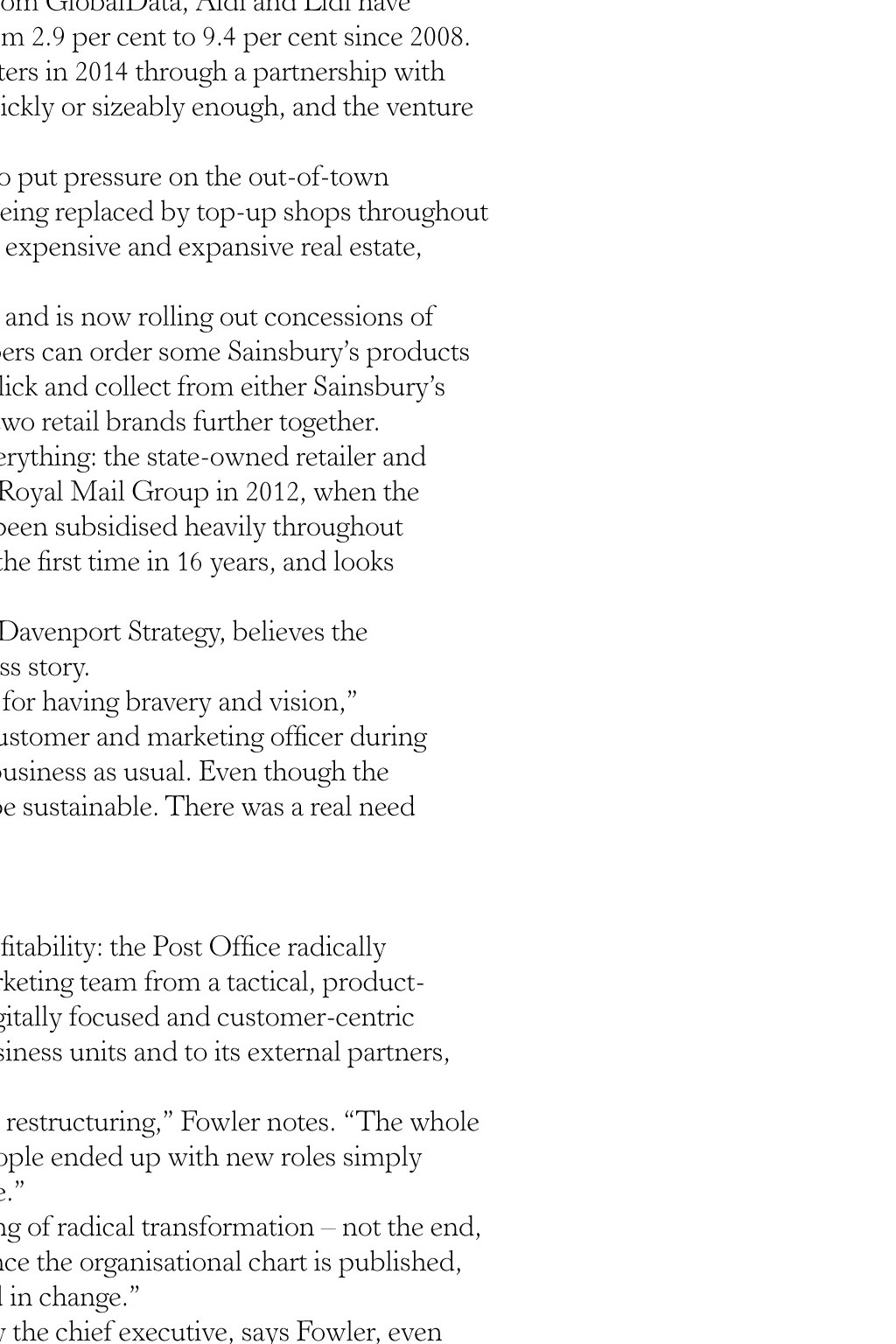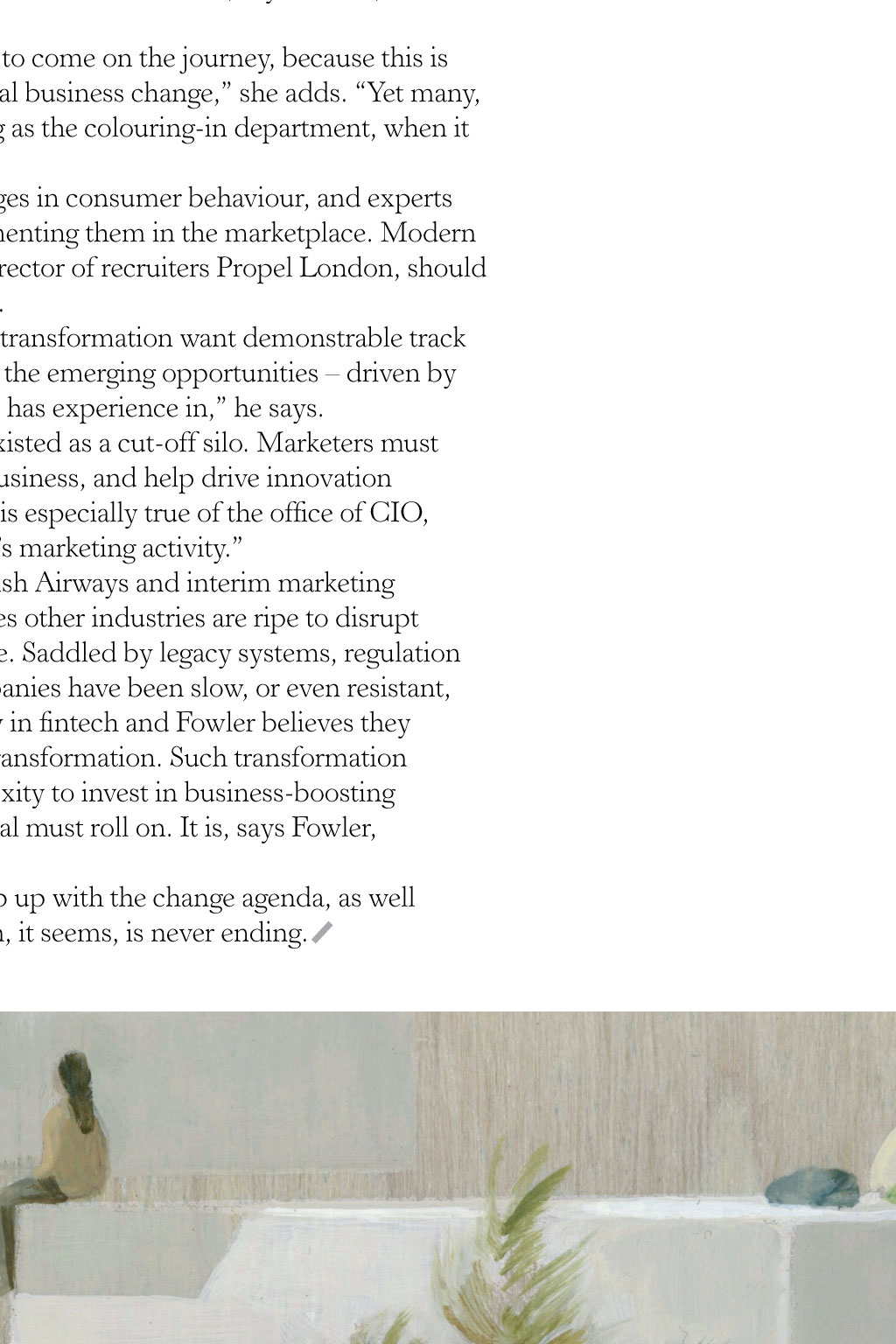
























Analysis Creating a platform for change With marketers increasingly tasked with delivering radical transformation for their organisations, when is the right time to strike and how can leaders learn from this state of constant re-engineering in which many businesses find themselves? Words: Catherine Turner Illustration: cinta vidal T his business is on a burning platform, said Marks & Spencers chairman Archie Norman in July of this year. We dont have a God-given right to exist, and unless we change and develop this company the way we want to, in decades to come there will be no M&S. Norman has been dubbed the turnaround king for his work in transforming the fortunes of brands, including Asda. When he joined the supermarket as CEO in 1991, its reputation was so dire that Norman was, apparently, the only candidate for the role. Today, Norman faces similar organisational and operational challenges at M&S, which is among Britains best-loved brands. Arriving in 2017, he issued an immediate call to arms: Over not five years, but probably 15 and maybe even 20 years, the business has failed to change in line with the customer, and as quickly as the competition, he noted. The failure is not to do with the strategy or the intellectual approach nearly as much as it is to do with the organisation, the culture and the capability. Months later, he was more strident still: there is no doubt that the business faces formidable headwinds and transformational changes are needed... Accelerated change is the only option. A brave rallying call, but one that experts and one suspects Norman himself believe should have come sooner. The speed read Marketing must power change in line with changing customer needs Disruption is a constant threat that needs constant attention Real transformation may require wholesale organisational change Marketing cannot be siloed if it is to deliver on innovation and profits Internal competition can be as transformative as external pressure Time for change For many, the right time to strike is precisely the time when most people wont, for the simple reason that the business is operating from a position of strength why change a winning formula? Martin Friesl, professor of strategic management at Lancaster University Management School, cautions: Many large-scale transformations begin when companies see the first signs of profit decline yet, at that point, it is almost too late. Companies are already on the back foot and not operating from a position of strength. Instead, Friesl urges leaders to be brave and buy the idea of radical shifts within the context of a very profitable business; that should be the time to transform. Every company is in constant danger of being disrupted. Senior marketers must be able to spot this threat before it happens and help their company profit from its underlying forces. Many famously disrupted companies such as Blockbuster, Blackberry and Jessops ran into their deepest troubles a decade or more after some of the warning signs appeared. None of their leaders developed effective transformation plans in time to halt the decline, say Innosights Scott D Anthony and Evan I Schwartz in their study of what the best transformational leaders of S&P 500 and Global 500 firms do. Their Transformation 10 Amazon, Netflix, Priceline, Apple, Aetna, Adobe, DaVita, Microsoft, Danone and ThyssenKrupp ranked highest in new-growth transformation. Each excelled in the development of new products, services and business models, repositioning their core business and financial performance. The list isnt solely made up of the new wave of global tech companies; healthcare gets a look in with Aetna and DaVita, ThyssenKrupp covers steel and engineering, and Danone brings food to the list. Tesco recently launched its new discount brand Jacks in a bid to take on Aldi and Lidl. The new retail format will be operated separately from the core Tesco business and, as such, benefits offered will be different from those offered at Tesco, the company said at the time. Mark Dodds, chairman of CIMs Food, Drink and Agriculture committee, commented: Our insight shows shoppers today are looking for low-frills, low-price groceries, which is why it makes sense for Tesco to introduce Jacks. Meanwhile, supermarket rivals Sainsburys and Asda are engineering a merger. Supermarkets also face increased competition from Amazon, which owns Whole Foods Market and offers online sales of products from the likes of Morrisons and Booths. Friesl says its a bold move by Tesco but at the right time, having recently posted a sharp rise in annual profits under CEO Dave Lewis. How will a company that has a very strong brand Engines of change: structural and a very strong existing strategy separation and reintegration transform? he asks. This comes after axing Tesco Direct earlier this year, which is widely seen as an acknowledgement that the retailer could not out-Amazon Amazon. Disrupting price and profit The threat from the discounters is real and already happening. According to figures from GlobalData, Aldi and Lidl have increased their combined market share from 2.9 per cent to 9.4 per cent since 2008. Sainsburys attempted to beat the discounters in 2014 through a partnership with Netto, but the scheme failed to expand quickly or sizeably enough, and the venture was shuttered just two years later. Changing consumer behaviour has also put pressure on the out-of-town hyperstore: big weekly shops are quickly being replaced by top-up shops throughout the week. The supermarkets, saddled with expensive and expansive real estate, have diversified. Take Sainsburys, which bought Argos and is now rolling out concessions of Argos and Habitat across its stores. Shoppers can order some Sainsburys products via Argos for next-day home delivery, or click and collect from either Sainsburys or Argos stores, in a move that brings the two retail brands further together. For the Post Office, too, timing was everything: the state-owned retailer and services provider became independent of Royal Mail Group in 2012, when the postal services arm was privatised. It had been subsidised heavily throughout its history but, in 2017, turned a profit for the first time in 16 years, and looks set to do so again in 2018. Louise Fowler, director at consultants Davenport Strategy, believes the Post Offices transformation is a real success story. I particularly applaud the Post Office for having bravery and vision, says Fowler, who served as interim chief customer and marketing officer during its transformation. Its all too easy to do business as usual. Even though the business is government-owned, it had to be sustainable. There was a real need to do something. The role of marketing This is not just about marketing its about fundamental business change louise fowler, director, davenport strategy Marketing has been key in this road to profitability: the Post Office radically changed the shape and structure of its marketing team from a tactical, productand channel-led function to a strategic, digitally focused and customer-centric one. It is aligned more closely with the business units and to its external partners, such as agencies. A big part of that change was through restructuring, Fowler notes. The whole leadership changed and an awful lot of people ended up with new roles simply because the old roles didnt exist any more. Yet any restructure is only the beginning of radical transformation not the end, she adds. Too many people think that, once the organisational chart is published, the job is done. It isnt; it takes time to bed in change. Change must also be fully endorsed by the chief executive, says Fowler, even if the impetus has come from elsewhere. Marketing has to influence the board to come on the journey, because this is not just about marketing it is fundamental business change, she adds. Yet many, many organisations still think of marketing as the colouring-in department, when it is so much more. Marketers are at the vanguard of changes in consumer behaviour, and experts at building value propositions and implementing them in the marketplace. Modern marketers, says James Webb, managing director of recruiters Propel London, should be at the strategic heart of their businesses. Companies looking to deliver radical transformation want demonstrable track records in being able to adapt strategies to the emerging opportunities driven by technology in each market the candidate has experience in, he says. The days are gone when marketing existed as a cut-off silo. Marketers must be able to plug into every aspect of their business, and help drive innovation and revenue from every department. This is especially true of the office of CIO, given the technical nature of a lot of todays marketing activity. Fowler, a former chief marketer at British Airways and interim marketing director at online bank First Direct, believes other industries are ripe to disrupt themselves: the finance sector, for example. Saddled by legacy systems, regulation and politics, many financial services companies have been slow, or even resistant, to change. Many are now investing heavily in fintech and Fowler believes they will use those start-ups to deliver radical transformation. Such transformation doesnt come cheap; the scale and complexity to invest in business-boosting change is enormous and business as usual must roll on. It is, says Fowler, a big and difficult task. Marketers have to be relevant and keep up with the change agenda, as well as focus on the day to day. Transformation, it seems, is never ending. cim.co.uk/exchange Marketers must be able to plug into every aspect of the business, and help drive innovation and revenue james webb, managing director, propel london